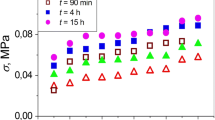Abstract
The heat generated from dissipative mechanisms during shearing and opening dominated dynamic fracture of polymethyl methacrylate and polycarbonate was measured with a remote sensing technique that utilizes the detection of infrared radiation. Significant heating was detected for both materials and both modes of fracture. In the shear dominated experiments, the temperature increase at the crack tip in polymethyl methacrylate was 85 K, the approximate increase necessary to reach the glass transition temperature. An adiabatic shear band followed by a dynamically propagating crack were observed during the shear dominated experiments using polycarbonate. The recorded shear band temperature increase was 45 K. This was followed by an additional 100 K temperature increase from the ensuing crack, raising the temperature above glass transition. The maximum temperature increase recorded for the opening mode experiments was 55 K for polymethyl methacrylate and 105 K for polycarbonate. The results of this study show that temperature effects are significant during the dynamic fracture of polymers. The effects are especially important in the shear dominated case where local temperatures approach or exceed the polymer glass transition temperature.
Similar content being viewed by others
References
Kambour, R.P. andBarker, R.E., “Mechanism of Fracture in Glassy Polymers. IV. Temperature Rise at the Tip of Propagating Crack in Poly(Methyl Methacrylate),”J. Polymer Science: Part A-2, (4),359–363 (1966).
Sun, N. S. andHsu, T. R., “Thermomechanical Coupling Effects on Fractured Solids,”Int. J. Fracture,78 (1),67–87 (1996).
Kallivayalil, J.A. andZehnder, A.T., “Measurement of the Temperature Field Induced by Dynamic Crack Growth in Beta-C Titanium,”Int. J. Fracture,66 (2),99–120 (1994).
Fuller, K.N.G., Fox, P.G., andField, J.E., “The Temperature Rise at the Tip of Fast Moving Cracks in Glassy Polymers,”Proc. Royal Society of London A (341),537–557 (1975).
Döll, W., “Application of an Energy Balance and an Energy Method to Dynamic Crack Propagation, Int. J. Fracture,12 (4),595–605 (1976).
Rittel, D., “Experimental Investigation of Transient Thermoelastic Effects in Dynamic Fracture,”Int. J. Solids and Structures,35 (22),2959–2973 (1998).
Kalthoff, J.F. andWinkler, S., “Failure Mode Transition at High Rates of Shear Loading,”Impact Loading and Dynamic Behaviour of Materials, C.Y. Kunze, H.D. Chiem, andL.W. Meyer eds., Springer Verlag, Berlin (1987).
Duffy, J., “Temperature Measurements during the Formation of Shear Bands in a Structural Steel,”Mechanics of Material Behavior, G.J. Dvorak andR.T. Shield, eds., Elsevier Science Publishers, Amsterdam, 75–86 (1984).
Ravi-Chandar, K., “On the Failure Mode Transitions in Polycarbonate under Dynamic Mixed Mode Loading,”Int. J. Solids and Structures,32 (6),925–938 (1995).
Ravi-Chandar, K., Lu, J., andZhu, Z., “Failure Mode Transitions in Polymers under High Strain Rate Loading,”Int. J. Fracture,101 (1–2),33–72 (2000).
Rosakis, A.J., Samudrala, O., andCoker, D., “Cracks Faster Than the Shear Wave Speed,”Science,284 (5418),1337–1340 (1999).
Incropera, F.P. andDeWitt, D.F., Fundamentals of Heat Transfer, John Wiley & Sons, New York, 582–589 (1980).
Hodowany, J., Ravichandran, G., Rosakis, A.J., andRosakis, P., “Partition of Plastic Work into Stored Energy in Metals,”Experimental Mechanics,40 (2),113–123 (2000).
Li, Z., andLambros, J., “Dynamic Thermomechanical Behavior of Fiber Reinforced Composites,”Composites Part A—Applied Science and Manufacturing,31 (6),537–547 (2000).
Krishmaswamy, S., Rosakis, A.J., andRavichandran, G., “On the Extent of Dominance of Asymptotic Elastodynamic Crack-tip Fields: Pt. 2—Numerical Investigation of Three-dimensional and Transient Effects,”J. Appl. Mech.,58 (1),95–103 (1991).
Zhou, M., Rosakis, A.J., andRavichandran, G., “Dynamically Propagating Shear Bands in Impact-loaded Prenotched Plates—I. Experimental Investigations of Temperature Signatures and Propagation Speed,”J. Mech. & Physics of Solids,44 (6),981–1006 (1996).
Rittel, D., “Experimental Investigation of Transient Thermoplastic Effects in Dynamic Fracture,”Int. J. Solids & Structures,37 (21),2901–2913 (2000).
Döll, W., “Fractography and Failure Mechanisms of Amorphous Thermoplastics,”Fractography and Failure Mechanisms of Polymers and Composites, A.C. Roulin-Moloney, ed. Elsevier, New York, 387–436 (1989).
Sharon, E., Gross, S. P., andFineberg, J., “Energy Dissipation in Dynamic Fracture,”Physical Review Letters,76 (12),2117–2120 (1996).
Mason, J.J., andRosakis, A.J., “On the Dependence of the Dynamic Crack Tip Temperature Fields in Metals upon Crack Tip Velocity and Material Parameters,”Mechanics of Materials,16 (4),337–350 (1992).
Nowinski, J.L., Theory of Thermoelasticity with Applications, European Printing Cooperation, Ireland (1978).
Singh, R.P., Lambros, J., Shukla, A., andRosakis, A., “Investigation of the Mechanics of Intersonic Crack Propagation along a Bimaterial Interface Using Coherent Gradient Sensing and Photoelasticity,”Proc. Royal Society of London A, (453),2649–2667 (1997).
Author information
Authors and Affiliations
Rights and permissions
About this article
Cite this article
Bjerke, T., Lambros, J. Heating during shearing and opening dominated dynamic fracture of polymers. Experimental Mechanics 42, 107–114 (2002). https://doi.org/10.1007/BF02411057
Received:
Revised:
Issue Date:
DOI: https://doi.org/10.1007/BF02411057




